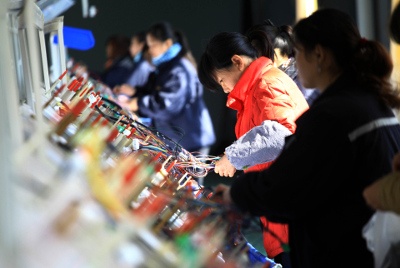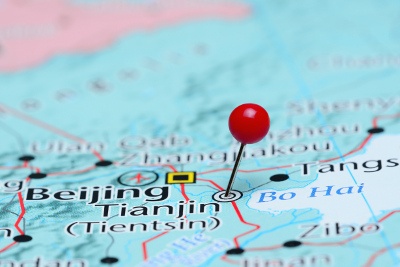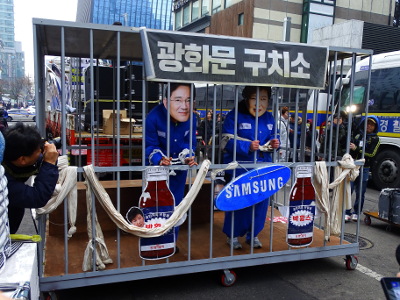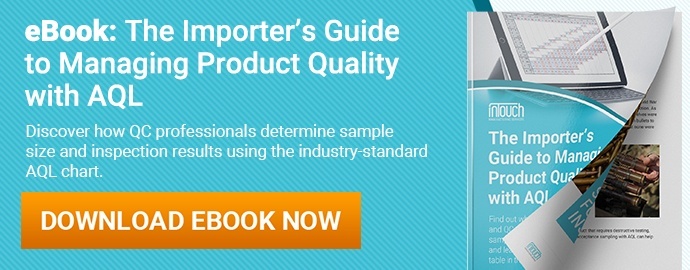Each Sunday, we publish a list of top articles and other content related to manufacturing in areas like quality control, product development, supply chain management, sourcing, auditing and law.
1. The toxic conditions slowly killing the Chinese workers that make your products
People make sacrifices every day for a variety of causes and people. And in some cases, people make sacrifices to create your products, too.
 This is the case when it comes to a handful of goods manufactured in China. Workers sacrifice their health, sometimes knowingly, sometimes not, to deliver a shiny new gadget, sturdy storage container, colorful t-shirt and more to markets everywhere.
This is the case when it comes to a handful of goods manufactured in China. Workers sacrifice their health, sometimes knowingly, sometimes not, to deliver a shiny new gadget, sturdy storage container, colorful t-shirt and more to markets everywhere.
Not all products are made in a toxic work environment. Some factories protect their employees and embody all the qualities of a good supplier. But still, there are enough factories using noxious materials to warrant the production of the documentary mentioned in the link at the end of this synopsis.
Complicit tells the story of numerous factory workers that have come into contact with chemicals while producing electronic products in Shenzhen and Guangzhou, both located in China’s southern Guangdong province.
The health problem highlighted by the documentary sends thousands of migrant workers to hospitals each year for occupational disease and could even be a reason for Chinese labor unrest. For example, six million workers suffer from the severe lung disease pneumoconiosis alone – and that’s not even including other forms of occupational disease.
To talk about this issue abstractly, however, doesn't do it justice. I got goosebumps as I read this one tidbit, a real story from the film:
We see 26-year-old Ming Kunpeng, who has leukaemia after being exposed to benzene, sit silently on his hospital bed next to his father. Doesn’t he want to go home, asks his father. His grandmother would like to see him. Ming later kills himself, aged 27.
After such a heart-sinking story, we’re all reminded of the importance of adhering to social compliance regulations, not just for business reasons, but for ethical ones as well. The fate of thousands if not millions of workers everywhere really does depend on the regulations to protect their lives and futures.
To read more about toxic manufacturing and its toll on workers, follow the link below:
China’s Workers Need Help to Fight Factories’ Toxic Practices – Victoria Turk, New Scientist
2. The Augmented Age
It goes without saying that mankind has made some pretty serious technological progress over the past millennia. Just imagine: eons ago, we were using stone tools to make fire and barely get by. Nowadays, humanity uses increasingly sophisticated technology to control precise machines to build products to not only survive, but thrive.
The presenter of this TED Talk, Maurice Conti, goes into details about several extremely interesting aspects of the Augmented Age, including:
- Cognitive augmentation
- Using algorithms that understand geometry and have constraints and goals to come up with optimized products
- Designing products that people naturally want
- The transition from passive to generative to intuitive tools
- Technology amplifying our abilities to do things that would otherwise be out of our reach
- Humans and robots working together to make all the new “stuff” possible because of the Augmented Age
- And more!
You can learn about this fascinating subject by checking out the video below:
Or if you’d prefer to watch it on YouTube, you can follow this link:
The Incredible Inventions of Intuitive AI – Maurice Conti TED Talk
3. Secondary cities: a potential source of future growth
Chicago. Paris. Berlin. Beijing. Mexico City. When you imagine significant cities, these might be a few of the first ones that come to mind. And while there are plenty of other major cities that you could add to this list, there’s another type of city that you might be overlooking: secondary cities.
As this article mentions, some secondary cities to consider are Tianjin in China, Pittsburgh in the United States, Barcelona in Spain and Bengaluru in India. In this case, too, the list provided isn’t exhaustive – these are merely examples. But what these cities offer is a unique chance for policymakers to use special initiatives, strategies and policies to foster remarkable economic growth and opportunity.
The advantage of secondary cities is exemplified by this snippet from the article:
…secondary cities like Tianjin will have an outsized role in the coming decades. Intermediate cities are among the fastest growing and most creative places in the world, and often the economic engine of their larger counterparts.
The potential secondary cities offer to the world might take many different forms. In some cases, one might become a hub for natural resource extraction and processing. In others, a secondary city might become a hot spot for manufacturing, sourcing and entrepreneurship. And when these cities are connected to primary cities, there’s no telling what sort of one-of-a-kind value they’ll add to the world.
If you’d like to read more about secondary cities and their potential, check out the full article in the link below:
The Rising Importance of the ‘Secondary’ City – Darryle Ulama, GE Reports
4. Avoiding negotiating mishaps in China
Imagine beginning a business trip to China with a dinner with your supplier. All seems to be going well – people are getting along, laughing and eating together. There’s plenty of small talk, but it seems like there’s no real substance to the occasion…yet.
And then the time comes for the toast to the future. Your Chinese counterparts mention what seem like innocuous words. You say something similarly cordial and hopeful about the prospects of your collaboration. Now, it’s time to delve into details.
Unfortunately, there’s already a potential problem because there might be some assumptions underlying each side’s toast. Your party and the Chinese are likely on different wavelengths. You can, however, remedy this gap in understanding and the potential for a sour business relationship by following the tips mentioned by the author of this featured content:
- “Manage the agenda, and then focus on individual deal points”
- “Avoid the slippery slope of concessions. Once you give in it never ends.”
- “You’re in the same boat – but who is the captain and who is the crew?”
The author frames these negotiating lessons in the context of the recent visit of U.S. Secretary of State Rex Tillerson to China. While everyone’s negotiations might not be of the same national significance as Tillerson’s, that doesn’t mean we can’t all benefit from what his experience offers.
The author actually recommends 5 lessons. Three are listed above, but you’ll have to see the full article for the remaining two. Follow the link below to keep reading about this topic:
5 Negotiating Lessons from Sec. of State Tillerson’s Beijing Trip – Andrew Hupert, China Solved
5. Challenges for the future of South Korean manufacturing
South Korea has been hit hard in the last year by a significant problem – political turmoil. The impeachment of former president Park Geun-hye was a major moment in the country’s history that sent shockwaves throughout the region and world.
 But this event is far from just political. There are economic implications as well considering how Samsung Electronics is also being dragged into the fray. While the company’s role in the impeachment scandal is apparently minor, Lee Jae-yong, the vice chairman of Samsung, has been indicted, which could disrupt the operations of one of South Korea’s biggest companies.
But this event is far from just political. There are economic implications as well considering how Samsung Electronics is also being dragged into the fray. While the company’s role in the impeachment scandal is apparently minor, Lee Jae-yong, the vice chairman of Samsung, has been indicted, which could disrupt the operations of one of South Korea’s biggest companies.
The article mentions how,
The end of the Samsung era may herald the downfall of a wide range of South Korean manufacturing sectors from shipbuilding to steel and automobiles.
The problems Samsung might face are significant enough, in the opinion of the author of this featured article, that there might be a ripple effect throughout the rest of South Korea’s manufacturing sector. And this is on top of other troubling events in the South Korean economy, like the collapse of Hanjin Shipping Company.
Do you think these issues are really that significant and will there actually be a ripple effect throughout South Korean manufacturing? Let us know in the comments below.
To read more about this topic, check out the full article in the link below:
Troubling Times for South Korean Manufacturing – The Japan Times
We’re constantly scanning the web for top manufacturing stories and news. If you’d like to submit an article for consideration for our weekly Best in Manufacturing, send us a message and let us know.







